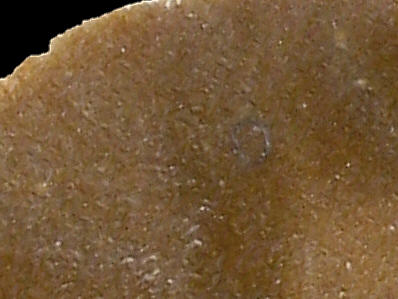
Foto: Jehanne Féblot-Augustins, 2005.
- Les Côtes
Sampled sites:
| Material name: | Ur |
| Synonyms: | N/A |
| Material (geologic): | Urgonian (Early Cretaceous) flint |

Foto: Jehanne Féblot-Augustins, 2005. |
Sampled sites:
|
| Mode of occurrence: | 3 cm thick fragments of tabular flint. |
| Cortex: | Superficially pitted, worn but still rough to the touch, light grey, 0.5 cm, transition sharp. |
| Colour: | Dark brown (10YR 4/3). |
| Pattern: | Featureless. |
| Appearance: | Very homogeneous material, dull and opaque, moderately smooth, fine-grained. |
| Structure: | Grains regularly and uniformly distributed. |
| Texture: | Wackestone. |
| Matrix: | Subtranslucent, to translucent in thin flakes. |
| Grains: | 40 to 50 % ; angular to rounded grains, white, yellow, and orange, well sorted (100 to 150 µ); blurred, milky and hardly visible elements (250 µ); finely scattered dust-sized angular fragments of carbonaceous matter (<40 µ). |
| Grain composition: | Rare sponge spicules, serpulids, rare black "ghosts" outlined by impurities (foraminifera ?); abundant carbonaceous elements, frequent iron oxides and detrital quartz. |
| Further information: | Click here for the original French description (opens in a new window), or here for more information on the attributes used in the description (use your browser's "BACK"-button to return here). |
| Citing: | Information on citing this page can be found here. |
| Locality: | Andert-et-Condon / Andert - Les Côtes, France, Ain department |
| Synonyms: | Sampling site Bugey 52 after Féblot-Augustins |
| Geographical description: | N/A |
| Geographical co-ordinates: |
east/x 858,4 north/y 2092,2 (Lambert zone II, NTF)
This corresponds roughly with |
| Co-ordinate precision: |
The coordinates given were taken from a large-scale map, and are within approx. 50 metres of the actual spot. The latitude/longitude coordinates are a direct transformation of these data on WGS84 and are accurate to the same level, so don't be deceived by the apparently high precision to the second. The location can be found on the 1:25 000 topographical map sheet 3231 E of the French Institut Géographique National. |
| Geology: |
According to the geological map, the substrate is of Oligocene age (unit 'g'). The flint istself originates in Early Cretaceous sediments and lies here in a secondary position. Map of all sampled localities of Early Cretaceous flint in the Bugey (PDF, 300 KB, opens in new window). |
| Type of source: | Secondary. |
| Other types of flint: | Apart from the Urgonian flint (type Ur), quite a lot of other flint types can be found here, predominantly of Late Cretaceous (Senonian) age: CC2, CC3a, CC3b, CC4a, CC4b |
thumb.jpg) Foto: Jehanne Féblot-Augustins, 2005 |
thumb.jpg) Foto: Jehanne Féblot-Augustins, 2005 |
| Last modified on: November 15, 2005 |
Contents primarily by: Jehanne Féblot-Augustins |
Comments to: |